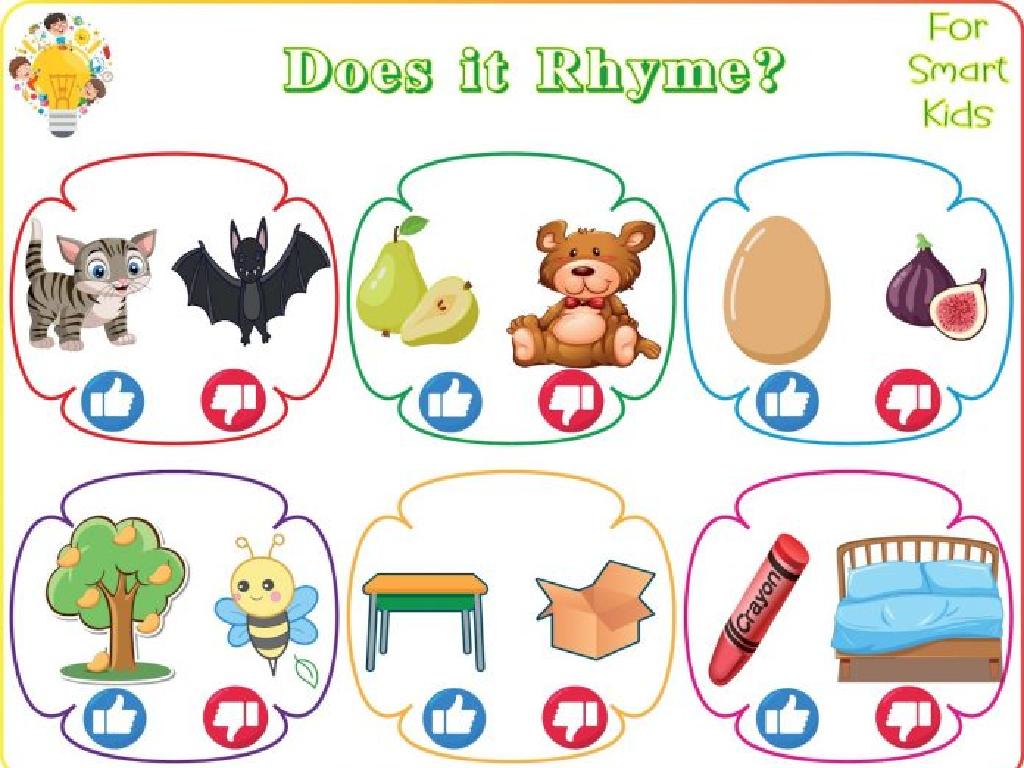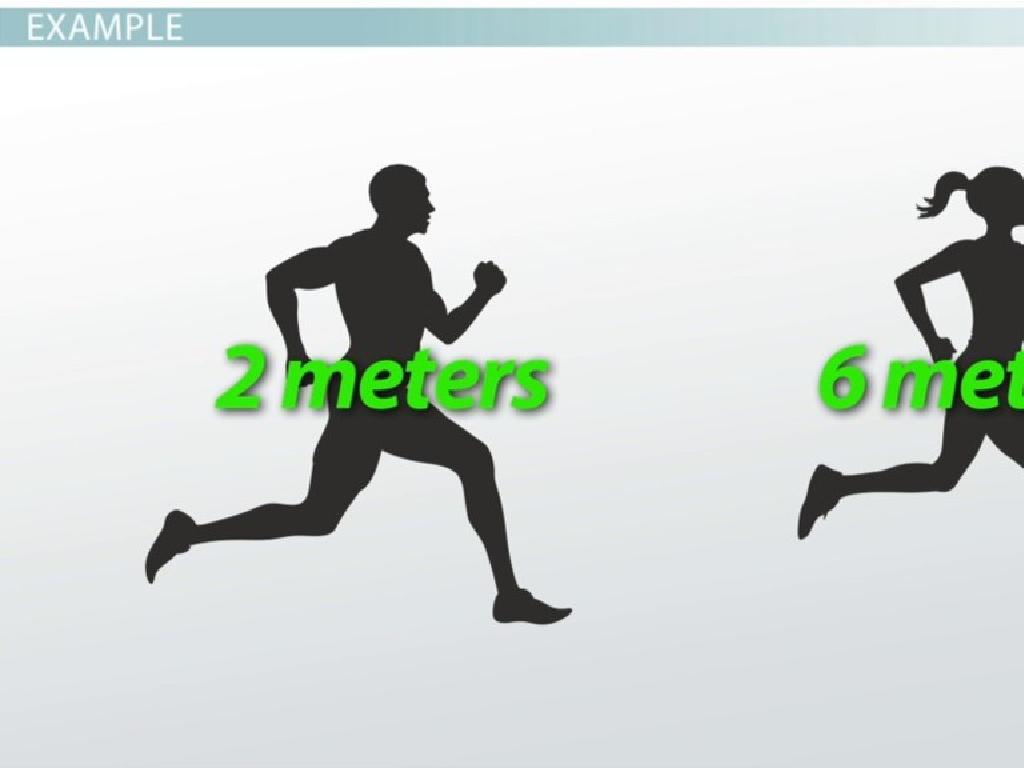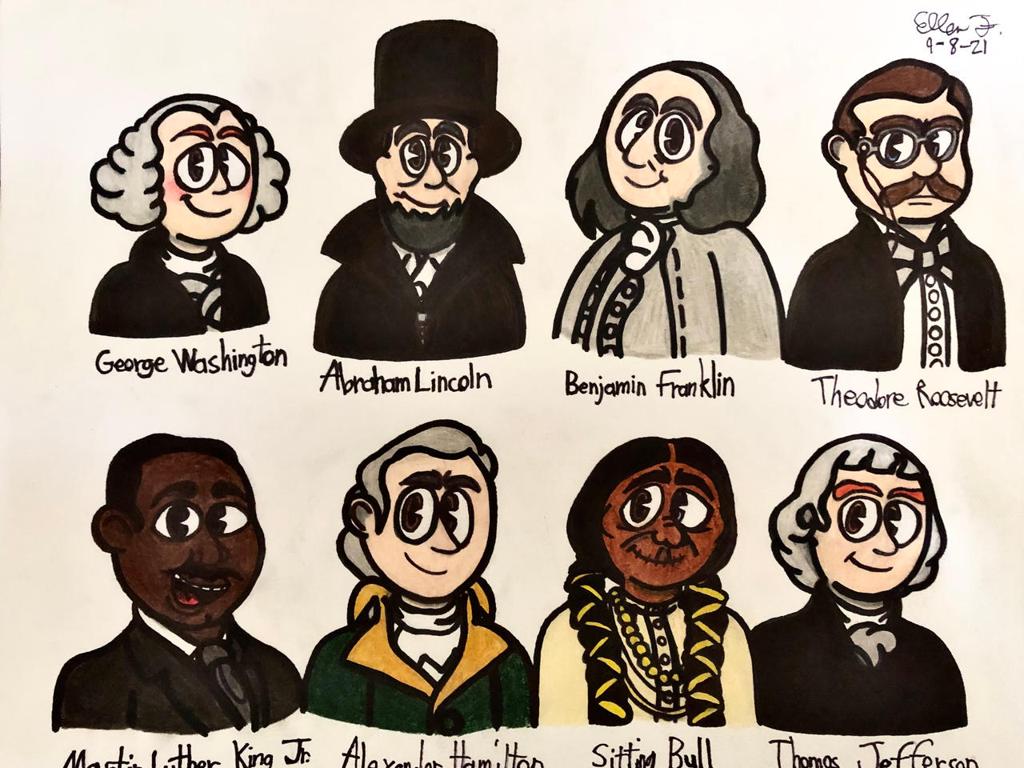Body Systems: Perception And Motion
Subject: Science
Grade: Fourth grade
Topic: Animals
Please LOG IN to download the presentation. Access is available to registered users only.
View More Content
Welcome to Body Systems: Perception and Motion
– Discovering animal perception
– Animals use senses to interact with their environment, like bats using echolocation.
– Human senses and their roles
– We have 5 senses: sight, hearing, smell, taste, and touch, each with a special function.
– Investigating animal movement
– Animals move in various ways, like birds flying or fish swimming.
– Comparing human and animal motion
– Humans walk on two legs, while many animals use four legs or other methods to move.
|
This slide introduces the concept of perception and motion in the animal kingdom, with a focus on how animals, including humans, use their senses to perceive the world and move within it. Start by discussing the different senses animals have and how they use them to survive. Then, explore the human senses, explaining the role of each. Next, look at the various ways animals move, such as flying, swimming, or crawling, and compare these to human bipedal motion. Encourage students to think about their own experiences with movement and how they use their senses daily. This will help them relate personally to the material and better understand the similarities and differences between humans and other animals.
Exploring Body Systems in Animals
– Body systems: teamwork in our body
– Organs and tissues form systems for specific functions.
– Examples: nervous, muscular, skeletal
– Nervous system senses the world; muscular system moves us; skeletal system supports.
– Each system’s unique role
– Digestive system breaks down food, respiratory system helps us breathe, etc.
– Working together for our health
|
This slide introduces the concept of body systems to fourth-grade students, emphasizing the idea that these systems are like teams where each member (organ or tissue) has a specific role. Provide examples of different systems such as the nervous system, which allows us to feel and react; the muscular system, which helps us move; and the skeletal system, which gives our body structure and support. Highlight that each system has a unique function but all work together to keep our body healthy and functioning properly. Encourage students to think of other systems they know and how they might help our body. This sets the stage for deeper discussions on each system and their importance to our overall well-being.
The Nervous System: Our Body’s Control Center
– Nervous system as control center
– It sends signals to and from the brain to the body
– Brain, spinal cord, and nerves
– The brain is the boss, the spinal cord is the messenger, and nerves are the pathways
– Sensing and responding to the world
– We feel heat or cold and know to wear a jacket or sunscreen
– Quick decisions and actions
|
The nervous system is crucial for all bodily functions and is akin to a control center. It consists of the brain, which is like the command center, the spinal cord, which acts as the communication highway, and the nerves, which are the vast network of ‘roads’ that reach every part of our body. This system allows us to perceive our environment like feeling temperature changes and make appropriate responses, such as putting on a jacket when it’s cold. It’s also responsible for quick reflexes, like pulling your hand away from a hot stove. During the presentation, use relatable examples to help students understand how the nervous system works and why it’s important for our daily life.
Senses Help Us Perceive the World
– Five main senses: sight, hearing, smell, taste, touch
– Eyes, ears, nose, tongue, and skin gather different information
– Senses send info to our brain
– Nerves carry signals from our senses to the brain
– Understanding our environment
– Our brain interprets these signals to make sense of the world
– Exploring how each sense works
– We’ll discover the amazing ways our senses function
|
This slide introduces the concept of the five main senses and their role in perception. Emphasize that each sense organ is specialized to collect specific types of information, which is then sent to the brain via nerves. The brain processes this information, allowing us to understand and interact with our environment. Encourage students to think about how they use their senses in daily life and prepare them for a deeper dive into the science behind how each sense works. Activities can include matching senses to their functions or exploring sensory experiences in the classroom.
Sight: Seeing the World
– Eyes capture light to see
– Light enters our eyes and is converted into signals for the brain.
– We perceive colors, shapes, movement
– Our vision lets us enjoy a world full of vibrant colors and diverse shapes.
– Eyes help animals navigate
– Animals rely on sight to find food, avoid danger, and interact with others.
– Vision varies among animals
– Different animals have different levels of vision; some see more colors or have better night vision.
|
This slide introduces the concept of sight as part of the body’s perception system. Explain how the eyes work by capturing light and how the brain processes this to form images. Discuss the ability to see a variety of colors, shapes, and detect movement, which is crucial for understanding the environment. Emphasize the importance of eyesight in animals for navigation and survival. Highlight that vision can vary greatly among animals, with some having the ability to see ultraviolet light or having enhanced night vision. Encourage students to think about how different animals might see the world differently than humans.
Hearing: Listening to Sounds
– Ears detect sound waves
– Our ears transform waves into sounds we understand.
– Different pitches and volumes
– High pitch like a whistle, low pitch like a drum.
– Hearing aids communication
– Talking and listening are key in conversations.
– Alertness to danger
– Sounds warn us, like a fire alarm.
|
This slide introduces the concept of hearing within the context of animal perception and motion. It explains how the ears function as receivers of sound waves, which are then interpreted by the brain as different sounds. Emphasize the variety of sounds we can hear, from high to low pitch and soft to loud volumes. Discuss how hearing is crucial for communication, allowing us to exchange ideas and express emotions. Also, highlight how hearing keeps us safe by alerting us to potential dangers, such as a car horn or a smoke detector. Engage the students by asking them to share experiences where their hearing helped them in their daily lives.
Smell and Taste: Detecting Flavors
– Nose detects smells
– Tongue tastes flavors
– Enjoy food, avoid harm
– Smells and tastes help us decide what’s delicious or dangerous
– Animals: find food, avoid predators
– Animals rely on these senses for survival
|
This slide introduces the senses of smell and taste, focusing on their roles in perception and motion within the animal kingdom, including humans. The nose and tongue are sensory organs that detect smells and flavors, respectively. Together, they contribute to our enjoyment of food and our ability to detect potentially harmful substances. In the animal world, these senses are crucial for survival, aiding in locating food and evading predators. Encourage students to think of examples when they use their sense of smell and taste to experience the world around them. Discuss how animals might use these senses differently than humans.
Touch: Feeling the World
– Skin’s role in touch
– Our skin feels touch, pressure, pain, and temperature changes.
– Touch for interaction and safety
– We use touch to learn about our surroundings and avoid danger.
– Animals’ specialized touch senses
– Some animals have whiskers or unique skin to better sense their world.
|
This slide introduces the concept of touch as a sensory system that allows both humans and animals to perceive the world around them. The skin is highlighted as the primary organ for the sense of touch, capable of detecting various stimuli such as pressure, pain, and temperature changes. Emphasize the importance of touch in everyday life, such as using it to interact with objects and identify potential hazards, ensuring safety. Discuss how certain animals have evolved specialized structures, like whiskers in cats, which act as tactile sensors to navigate their environment. Encourage students to think about how they use their sense of touch daily and to consider the diverse ways animals might experience touch differently.
Motion: How Animals Move
– Animals use muscles and bones to move
– Humans walk, run, jump with these systems
– Our legs and arms have muscles that contract to create motion
– Animals move in diverse ways
– Fish swim, birds fly, kangaroos hop
– Exploring unique animal movements
– Let’s look at how a cheetah runs or a monkey swings
|
This slide introduces the concept of motion in animals, focusing on the role of muscles and bones. It’s important to convey to the students that while all animals move, they do so in different ways depending on their body structures. Highlight the muscular and skeletal systems in humans, explaining how muscles work together with bones to facilitate movement. Provide examples of various animal movements, such as swimming in fish or flying in birds, to illustrate the diversity of motion in the animal kingdom. Encourage students to think about their own experiences with movement and to observe animals in their environment or from videos to understand the practical application of these concepts.
Muscles and Bones at Work
– Muscles create movement by pulling
– Muscles attach to bones; when they contract, we move.
– Skeleton provides structure and support
– Think of your skeleton like the frame of a building.
– Joints enable bending and movement
– Joints are like hinges on a door; they help us bend.
– Working together for motion
|
This slide introduces the basic concepts of how muscles and bones work together to facilitate movement in animals, including humans. Explain that muscles are attached to bones and they contract (shorten) to pull on the bones, which creates movement. The skeleton, made up of all the bones in our body, provides the necessary structure and support, much like the framework of a building. Joints are the parts of our body where two bones meet and allow for different types of movement, such as bending our elbows or knees. Emphasize the synergy between these components that enables us to move in various ways. Use examples like flexing an arm to show a muscle at work, or comparing a knee joint to a door hinge to illustrate how joints function.
Class Activity: Sensory Scavenger Hunt
– Engage in a sensory scavenger hunt
– Find an item that’s smooth
– Feel different objects and decide which is the smoothest
– Locate a source of a loud sound
– Listen carefully to identify loud noises in the environment
– Choose something colorful
– Look around to spot the most vibrant color
|
This activity is designed to help students explore and understand their senses. They will use touch to find something smooth, hearing to identify something loud, and sight to choose something colorful. Provide guidance on safety, especially for the ‘loud’ item to ensure they don’t harm their hearing. Encourage them to think about how they use their senses every day. After the scavenger hunt, facilitate a discussion where students share their items and describe their experiences. Possible variations of the activity could include finding something with a distinct smell or something that makes a unique sound when touched.






